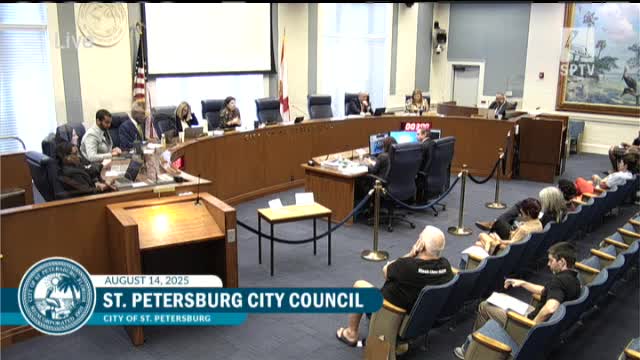St. Petersburg Council Refers Street Art Discussion To Housing Committee Amid State Memo
August 14, 2025 | St. Petersburg, Pinellas County, Florida
This article was created by AI summarizing key points discussed. AI makes mistakes, so for full details and context, please refer to the video of the full meeting. Please report any errors so we can fix them. Report an error »

In a recent St. Petersburg City Council meeting, discussions centered around the preservation of street art and murals in the face of a Florida Department of Transportation (FDOT) memorandum that calls for the removal of noncompliant pavement art. The council is considering forming a committee to address the implications of this directive, which has sparked significant community concern regarding the potential erasure of cultural and historical expressions.
Council members emphasized the importance of collaboration between the council and city administration to formulate a response that aligns with both safety regulations and the community's artistic identity. The FDOT memo, dated June 30, 2025, prohibits certain forms of pavement art, raising alarms among residents and local artists who argue that these artworks contribute to public safety and community pride.
Public speakers at the meeting passionately advocated for the protection of street art, highlighting its role in fostering a sense of belonging and cultural representation. Esther Sani, president of the St. Petersburg NAACP, urged the council to honor the city’s commitment to diversity and inclusion, referencing other cities that have successfully resisted similar pressures to remove murals celebrating marginalized communities.
Max McCann, a local resident, pointed out that street art not only enhances the aesthetic appeal of neighborhoods but also serves as a quick and cost-effective safety measure. He argued that the city should seek exceptions to the FDOT's directive, emphasizing the positive impact of street art on community safety and identity.
The council's discussions also touched on the potential economic ramifications of removing these artworks. Rachel Covello, a local business owner, noted that inclusive symbols attract tourists and contribute to the local economy. She warned that erasing these expressions could lead to a decline in tourism and community engagement.
As the council prepares to move forward with discussions in committee, they are tasked with balancing state mandates with the community's desire to maintain its cultural heritage. The legal implications of the FDOT memo remain a critical concern, with city officials seeking clarity on the potential withholding of state funds related to noncompliant traffic control devices.
In conclusion, the St. Petersburg City Council faces a pivotal moment as it navigates the intersection of state regulations and local identity. The outcome of these discussions will not only shape the future of street art in the city but also reflect St. Petersburg's commitment to inclusivity and cultural expression. The council plans to reconvene in September to further explore these issues and gather community input.
Council members emphasized the importance of collaboration between the council and city administration to formulate a response that aligns with both safety regulations and the community's artistic identity. The FDOT memo, dated June 30, 2025, prohibits certain forms of pavement art, raising alarms among residents and local artists who argue that these artworks contribute to public safety and community pride.
Public speakers at the meeting passionately advocated for the protection of street art, highlighting its role in fostering a sense of belonging and cultural representation. Esther Sani, president of the St. Petersburg NAACP, urged the council to honor the city’s commitment to diversity and inclusion, referencing other cities that have successfully resisted similar pressures to remove murals celebrating marginalized communities.
Max McCann, a local resident, pointed out that street art not only enhances the aesthetic appeal of neighborhoods but also serves as a quick and cost-effective safety measure. He argued that the city should seek exceptions to the FDOT's directive, emphasizing the positive impact of street art on community safety and identity.
The council's discussions also touched on the potential economic ramifications of removing these artworks. Rachel Covello, a local business owner, noted that inclusive symbols attract tourists and contribute to the local economy. She warned that erasing these expressions could lead to a decline in tourism and community engagement.
As the council prepares to move forward with discussions in committee, they are tasked with balancing state mandates with the community's desire to maintain its cultural heritage. The legal implications of the FDOT memo remain a critical concern, with city officials seeking clarity on the potential withholding of state funds related to noncompliant traffic control devices.
In conclusion, the St. Petersburg City Council faces a pivotal moment as it navigates the intersection of state regulations and local identity. The outcome of these discussions will not only shape the future of street art in the city but also reflect St. Petersburg's commitment to inclusivity and cultural expression. The council plans to reconvene in September to further explore these issues and gather community input.
View full meeting
This article is based on a recent meeting—watch the full video and explore the complete transcript for deeper insights into the discussion.
View full meeting